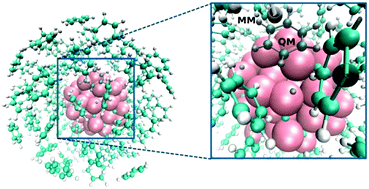Multiscale molecular modelling: from electronic structure to dynamics of nanosystems and beyond
Abstract
Important contemporary biological and materials problems often depend on interactions that span orders of magnitude differences in spatial and temporal dimensions. This Tutorial Review attempts to provide an introduction to such fascinating problems through a series of case studies, aimed at beginning researchers, graduate students, postdocs and more senior colleagues who are changing direction to focus on multiscale aspects of their research. The choice of specific examples is highly personal, with examples either chosen from our own work or outstanding multiscale efforts from the literature. I start with various embedding schemes, as exemplified by polarizable continuum models, 3-D RISM, molecular DFT and frozen-density embedding. Next, QM/MM (quantum mechanical/molecular mechanical) techniques are the workhorse of pm-to-nm/ps-to-ns simulations; examples are drawn from enzymes and from nanocatalysis for oil-sands upgrading. Using polarizable force-fields in the QM/MM framework represents a burgeoning subfield; with examples from ion channels and electron dynamics in molecules subject to strong external fields, probing the atto-second dynamics of the electrons with RT-TDDFT (real-time – time-dependent density functional theory) eventually coupled with nuclear motion through the Ehrenfest approximation. This is followed by a section on coarse graining, bridging dimensions from atoms to cells. The penultimate chapter gives a quick overview of multiscale approaches that extend into the meso- and macro-scales, building on atomistic and coarse-grained techniques to enter the world of materials engineering, on the one hand, and cell biology, on the other. A final chapter gives just a glimpse of the burgeoning impact of machine learning on the structure-dynamics front. I aim to capture the excitement of contemporary leading-edge breakthroughs in the description of physico-chemical systems and processes in complex environments, with only enough historical content to provide context and aid the next generation of methodological development. While I aim also for a clear description of the essence of methodological breakthroughs, equations are kept to a minimum and detailed formalism and implementation details are left to the references. My approach is very selective (case studies) rather than exhaustive. I think that these case studies should provide fodder to build as complete a reference tree on multiscale modelling as the reader may wish, through forward and backward citation analysis. I hope that my choices of cases will excite interest in newcomers and help to fuel the growth of multiscale modelling in general.

- This article is part of the themed collections: 2022 PCCP HOT Articles and PCCP Reviews


 Please wait while we load your content...
Please wait while we load your content...